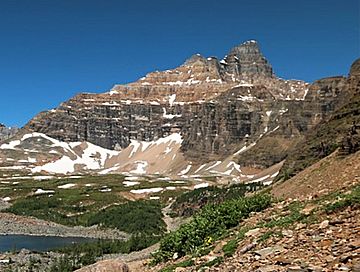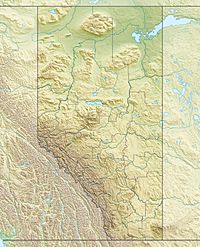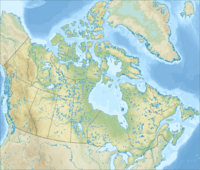Wenkchemna Peak facts for kids
Quick facts for kids Wenkchemna Peak |
|
|---|---|

Wenkchemna Peak
|
|
| Highest point | |
| Elevation | 3,206 m (10,518 ft) |
| Prominence | 16 m (52 ft) |
| Geography | |
| Location | Alberta British Columbia |
| Parent range | Canadian Rockies |
| Topo map | NTS 82N/08 |
| Type of rock | Sedimentary rock |
| Climbing | |
| First ascent | 1923 F.C. Bell, A.W. Drinnan, H. Herriot, T.B. Moffat, R. Neil, E. Thompson, R. Williams, Christian Hasler jr. |
Wenkchemna Peak is a mountain located on the border between Alberta and British Columbia in Canada. It was given its name in 1894 by Samuel E. S. Allen.
This peak is special because it is the 10th peak in the famous Valley of the Ten Peaks. When you look at the peaks from Moraine Lake, Wenkchemna Peak is usually counted from left to right. It is also connected to the ridge formed by Mount Hungabee and Ringrose Peaks.
What is Wenkchemna Peak Made Of?
Wenkchemna Peak is made of a type of rock called sedimentary rock. Imagine layers of sand, mud, and tiny bits of plants and animals settling at the bottom of ancient seas. Over millions of years, these layers get squished and hardened into rock. This is how sedimentary rock forms.
The rocks that make up Wenkchemna Peak were formed a very, very long time ago. Some were laid down during the Precambrian period, which was billions of years ago. Others formed during the Jurassic period, famous for dinosaurs, millions of years ago.
Later, during something called the Laramide orogeny, huge forces pushed these rocks. It was like giant plates of the Earth's crust crashing together. This pushed the older rocks up and over younger rocks, creating mountains like Wenkchemna Peak.
Weather at Wenkchemna Peak
Scientists use a system called the Köppen climate classification to describe different climates around the world. Based on this system, Wenkchemna Peak is in a subarctic climate zone.
This means the mountain has very cold winters with lots of snow. Summers are usually mild, not too hot. In winter, temperatures can drop below -20 °C (that's -4 °F!). With the wind chill, it can feel even colder, sometimes below -30 °C (-22 °F!).



